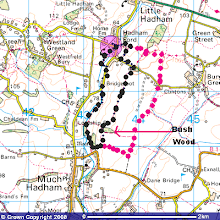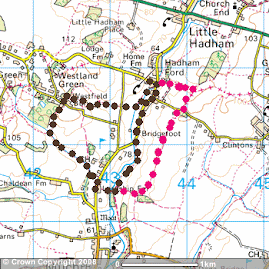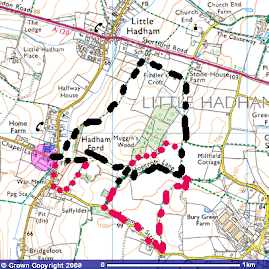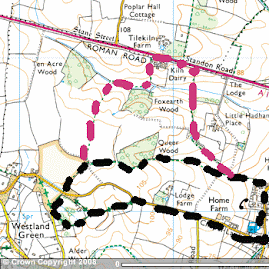Due to a spare day and Wendy being on grand children duty, I grabbed the chance of another visit to North Norfolk. I contacted Gary in Stortford and he was up for his first birding trip of the year and he was duly picked up at 6.30am. We had a coffee at Wells before 8.30am and then off to Salthouse to check if the snow buntings were still present. I had seen these here 22nd Jan and once we got close it was interesting to note the amount of birds that were moulting into adult male plumage, compared to the brown/fawn birds of a month ago.
 |
| 3 snow buntings: Salthouse beach |
 |
| Male moulting into breeding plumage |
 |
| Compare to the photo below taken on 22.01.18 at the same site. |
 |
| Displaying winter plumage |
 |
| Inevitable turnstones at the end of Beach Road, Salthouse |
A pair of stonechat and numerous linnets were also noted around Gramborough Hill before we did a quick sea watch but nothing at all, so to the car and off for another coffee at the NWT Visitors' Centre. There seemed to be little of note on the reserve at Cley so we drove around to the beach carpark for a check on the Eye Field and sea but not too much so off west. We dropped in at Blakeney and Morston where there were Brent geese and regular waders, so on to Holkham for a check on the sea and to see if the shore larks were still present as this is a species Gary has only seen on a few occasions. A buzzard, west towards Burnham Overy Staithe attracted our attention. Although distant, in good light, as it circled, a clear white rump denoting rough legged buzzard. A new for year sp. No sign of the larks even though an enthusiastic birder told us they were there and that he could actually see them as we were chatting. Others confirmed they were not present in their usual area. Interestingly, we decided to do a little searching and every time were stopped to scan the low vegetation we appeared to attract other birders hoping we were watching them.
Then, off for a sea watch. A Black throated diver was new for the year along with numerous red throated, both on the water and flying into The Wash. Great crested grebes, cormorants and gulls were also noted.
Back in Lady Anne's Drive, huge numbers of pink footed geese, wigeon and 10 snipe altogether.
 |
| Black headed gull |
 |
| Pink footed goose |
 |
| Stonechat, Holkham beach |
 |
| A wisp (or walk) of snipe |
 |
| Snipe, Lady Anne's Drive. |
From here we continued west, checking Brancaster harbour but nothing too unusual before grabbing some sustenance at Burnham Deepdale and a quick trip to Choseley Drying Barns. Nothing here at all so off to a very crowded Titchwell RSPB Reserve. A coffee and one of their excellent Bakewell Tarts and we were off.
First to the dragonfly pond where bramblings could be seen but were too far into vegetation for a photo. Siskins fed in the alders before we were off to the beach, having scanned the Volunteer Marsh for reported water and rock pipits. Weather remained fine as we set up our Scopes on the beach. Wigeon a plenty, great crested grebe, flyby red throated divers, goldeneye and a few scoter before a few red breasted mergansers were seen. A good session where I had a chat to Terry and Anne, birders now living in Hunstanton that I have known for many years. Good to see them.
 |
| Siskin |
 |
| Siskins feeding in alder |
 |
| Drake teal |
 |
| Muddy redshank |
 |
| Little Grebe |
 |
| Dunlin in late afternoon light |
 |
| Ringed plover in poor light |
We checked the Freshmarsh and Salt Marsh for waders, adding grey plover and avocet to the day list before returning to the car park and a last trip of the day, to Thornham. Here, we were checking for twite, not seen and a 2nd year Iceland Gull that may have goon into roost some way off Thornham Point. A scope scan through the several 1000 gulls present didn't give up a white winger, so back to the car and home just before 6.00pm.
Great day and good to catch up with Gary. Last time we were birding together was last May in The Camargue.
Species list for the day. (year listers in red)
- Red throated diver
- Black throated diver
- Little grebe
- Great crested grebe
- Cormorant
- Little egret
- Whooper swan
- Mute swan
- Pink footed goose
- Greylag goose
- Brent goose
- Shelduck
- Egyptian goose
- Canada goose
- Mallard
- Gadwall
- pintail
- shoveler
- wigeon
- Teal
- Pochard
- Tufted duck
- Common scoter
- Goldeneye
- Red breasted merganser
- Marsh harrier
- Rough legged buzzard
- Common buzzard
- Kestrel
- Red legged partridge
- Pheasant
- Moorhen
- Coot
- Oystercatcher
- Avocet
- Ringed plover
- Grey plover
- Golden plover
- Lapwing
- Knot
- Sanderling
- Turnstone
- Dunlin
- Redshank
- Black tailed godwit
- Bar tailed godwit
- Curlew
- Snipe
- Ruff
- Black headed gull
- Common gull
- Herring gull
- Lesser black backed gull
- Greater black backed gull
- Wood pigeon
- Collared dove
- Skylark
- Meadow pipit
- Pied wagtail
- Wren
- Dunnock
- Robin
- Stonechat
- Fieldfare
- Blackbird
- Great tit
- Coal tit
- Blue tit
- Magpie
- Jackdaw
- Carrion crow
- Rook
- Starling
- Chaffinch
- Brambling
- Linnet
- Lesser redpoll
- Siskin
- Goldfinch
- Reed bunting
- Snow bunting






























































